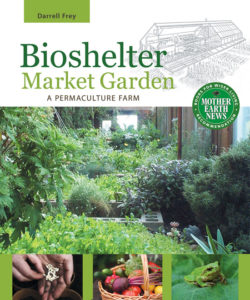Excerpted from Bioshelter Market Garden by Darrell Frey
Marketing Farm Products
Market gardening is two interwoven businesses; growing produce and selling produce. Writing in their book Natural Capitalism, Paul Hawken, Hunter Lovins and Amory Lovins, show that farmers’ income represent less than one percent of the gross domestic product of the US. However, “those who sell to and buy from farmers … have a share 14 times as large … These interests tend to squeeze out small, independent, and diversified farms.” Therefore, by selling farm products directly to retail customers, rather than to wholesale customers, a farmer can realize a better profit and develop a more secure position in the market.
The largest obstacles to profit in farming are the national and international policies that keep prices and wages low and resource-intensive production methods the norm.
Markets
Options for marketing produce include pick-your-own operations, on-farm markets, urban farmers’ markets, subscription sales, selling to wholesalers and processors, and direct sales to grocers, restaurants and other consumers. As explained by Janet Bachmann, in ATTRA ’s Market Gardening: A Startup Guide, the direct marketing options of “farmers’ markets, roadside stands, pick-your-own, subscription marketing arrangements and sales to restaurants [help farmers] “maximize their income [by] bypassing the middlemen.”
Our sales strategy at Three Sisters Farm is a mix of several approaches. Our primary strategy has been direct sales and subscription sales; we also do some Saturday on-farm sales. In pursuit of the best price we could get for our produce, we set up a delivery system to pass over the wholesalers. Direct marketing also allows us better control over the quality of our produce. When our label reaches the customer, we want the product to be as fresh as possible.
Our marketing strategies reflect our gardening system and philosophy. Developing a rotation of diverse annual crops and establishing perennial plantings ensures a healthy garden and minimizes the effects of crop failures. We grow lettuces, herbs, flowers, various salad crops and other gourmet vegetables. The crop mix and planting schemes have evolved as we attempt to cater to customers’ specific needs.
Our mixed sales strategies reflect an important permaculture principle: we have designed diversity into the system to create stability.
Direct Sales to Grocers and Restaurants
After a study of outlets for farm products, we concluded that selling directly to restaurants and grocers would be our best starting point. The local market was not large enough to support our sales goals. But driving 60 miles to Pittsburgh put us into a very large market. We began our sales promotion by calling chefs and arranging times to bring them samples. Face-to-face meetings allowed us to ask them directly what it was they needed and wanted.
Getting to know your customers’ needs is very important in marketing. Anticipating new and interesting produce they may want and discussing this in advance of the growing season helps with planning and instills confidence in the customer. And understanding a
You may also enjoy these excerpts from Bioshelter Market Garden:
This excerpt has been reprinted with permission from Bioshelter Market Garden by Darrel Frey and published by New Society Publishers, 2011.











